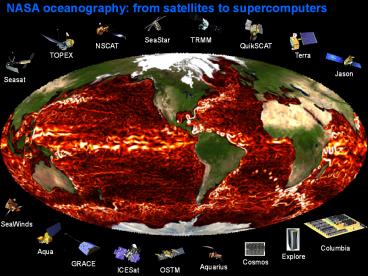Columbia - PowerPoint PPT Presentation
1 / 18
Title: Columbia
1
NASA oceanography from satellites to
supercomputers
SeaStar
TRMM
NSCAT
QuikSCAT
TOPEX
Terra
Jason
Seasat
SeaWinds
Columbia
Aqua
Explore
Cosmos
GRACE
Aquarius
ICESat
OSTM
2
Ocean carbon cycle
(Sarmiento and Gruber 2002)
3
ECCO Estimating the Circulation and Climate of
the Ocean
4
Mechanisms of air-sea CO2 flux variability in the
equatorial Pacific and the North
Atlantic (McKinley, Follows, and Marshall, 2004)
Mean CO2 flux (mol/m2/yr)
Hovmoller diagrams of simulated Equatorial
Pacific anomalies
First EOF of air-sea flux of CO2 and of sea
surface temperature
5
Carbon isotope evidence for the latitudinal
distribution and wind speed dependence of the
air-sea gas transfer velocity (Krakauer,
Randerson, Primeau, Gruber, and Menemenlis,
submitted)
Modeled latitudinal distribution of bomb
carbon-14 in the ocean, for a global mean gas
transfer velocity of 20.6 cm / hour and a
dependence on windspeed ranging from cubic to
none (n3, 2, 1 or 0).
6
Robust estimates of anthropo-genic carbon uptake,
transport, and storage by the ocean (Fletcher,
Gruber, Jacobson, Doney, Dutkiewicz, Follows,
Lindsay, Menemenlis, Mouchet, and Sarmiento,
submitted)
Transport, storage (bold) and surface flux
(italics) of anthropo-genic carbon in Pg C
Estimates of anthropogenic carbon uptake (Pg C /
yr)
7
Using ECCO estimates to simulate oceanic CFC
uptake
Zonal section of observed 1995 CFC-11
concentration ECCO simulation Difference
8
The processes responsible for Antarctic Bottom
Water formation are poorly understood and poorly
represented in climate models.
(slide courtesy of Ilana Wainer)
9
Sea-ice data products at NSIDC
What is still missing are direct observations of
sea ice thickness and snow cover.
10
ASOR Arctic Sea ice - Ocean (Re)analysis (Steele
, Lindsay, Rothrock, Schweiger, Zhang, and
Menemenlis)
Arctic Ocean model configuration with 40-km
horizontal grid spacing developed by J. Zhang.
Configuration is being used to experiment with
adjoint-method estimation of coupled ocean and
sea ice system.
Adjoint-method based estimates will be compared
to ASOR optimal interpolation estimates.
11
ECCO2 High-Resolution Global-Ocean and Sea-Ice
Data Synthesis
MIT Marshall, Heimbach, Hill Wunsch JPL Fu, Kwok,
Lee Menemenlis Zlotnicki GSFC Rienecker
Suarez ARC Henze, Taft HARVARD Tziperman GFDL Adcr
oft ARGONNE Hovland, Utke
Velocity (m/s) At 15 m depth
Objective synthesis of global-ocean and sea-ice
data that covers the full ocean depth and that
permits eddies. Motivation quantify role of
oceans in global carbon cycle, understand recent
evolution of polar oceans, monitor time-evolving
term balances within and between different
components of Earth system, etc., etc.
12
Chaotic behavior of coupled ocean and sea-ice
models
(Kauker, Karcher, and Gerdes)
13
Time-mean cost for sea ice area
Adjoint-model optimization with bulk formulae and
sea-ice
Baseline integration
Iteration 15
(Evangelinos, Heimbach, Menemenlis, and Wunsch)
14
Climatology cost has been reduced by 65 in 3
iterations
High-resolution Southern Ocean state estimate
(Mazloff, Heimbach, and Wunsch)
Iter. 3 - Iter. 0
Iteration 0
Iteration 3
Temperature
Salinity
15
Synthesis of the Arctic System Carbon
Cycle University of Alaska Fairbanks A.
David McGuire - lead PI Marine Biological
Laboratory Jerry Melillo Bruce
Peterson Jim McClelland Dave
Kicklighter MIT Ron Prinn Mick
Follows Purdue University Qianlai Zhuang
16
Darwinian Models of Ocean Ecology and
Biogeography (M. Follows, MIT)
Single ensemble member (Iseed 5007) Modelled
annual mean surface phyto (uM P)
SeaWiFS mean Chl
SeaWiFS coccoliths (mar 03)
17
Impact of high frequency variability on air-sea
gas exchange (McNeil and Menemenlis)
(Animation Henze, Hill, and Menemenlis)
18
- Summary and concluding remarks
- Sea ice is relatively well observed compared to
oceans. - But application of sea ice data in support of
global climate modeling is at early stage. - For ocean carbon cycle, need improved estimates
of water mass formation and transformation rates,
especially in Southern Ocean and North Atlantic. - In turn this requires increased resolution and
improved representation of sea ice, ice shelves,
and other high latitude processes in global
climate models. - Simulated coupled ocean and sea ice system
exhibits chaotic behavior. Problem with current
generation of models or intrinsic property of
coupled ocean-ice system? - Suggested estimation strategy is sequential
estimation of uncoupled components. First
results are promising but more work is needed. - Back-up estimation strategies, also being
considered but not discussed, are model Greens
functions and multiscale approaches.































